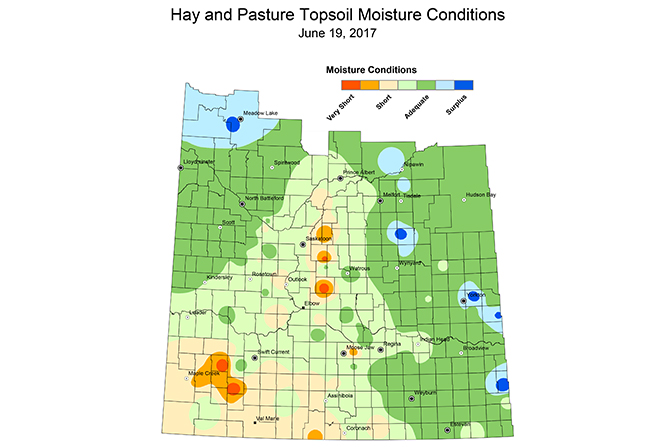
The widespread rain falling in Southwest Saskatchewan is a welcome sight as it is providing some relief for dry fields across the region.
The Saskatchewan Agriculture Crop Report for the period of June 13 to 19 shared that both the Assiniboia and Shaunavon regions were enduring driest conditions in the province. A full 90 per cent of the cropland, halyard and pasture land in the area south of Assiniboia were experiencing topsoil conditions in the short to very short range. The second driest area was around Shaunavon, where 60 per cent of cropland, 80 per cent of pasture land, and 84 per cent of hay land were enduring short to very short topsoil moisture levels.
The lack of moisture has slowed the development of crops across the region, with 19 per cent of fall cereals behind average, 35 per cent of pulse crops are behind normal, while 43 per cent of oilseeds and 48 per cent of spring cereals are behind their normal growing pace.
There was varying impacts across the region from rains which fell between June 13 and 19, with the Webb area receiving the highest rainfall at 40 millimetres.
Across the Southwest, the Crop Report notes that cropland topsoil moisture conditions are 51 per cent adequate, 39 per cent short and 10 per cent very short. Hay land and pasture topsoil conditions are in similar condition at 31 per cent adequate, 49 per cent short and 20 per cent very short.
The majority of crop damage this past week in the Southwest occurred as a result of the lack of moisture, wind, and insects such as cutworms. In-crop weed control is underway in areas with active weed growth, but strong winds have delayed producers from completing this work for several weeks now.
Province wide, 88 per cent of the fall cereals, 70 per cent of the pulse crops, 60 per cent of the spring cereals, and 56 per cent of the oilseeds are at or ahead of their normal stages of development for this time of year.
SaskPower has received 156 reports this year of farm equipment coming in contact with power lines, with 22 incidents being reported so far in June. SaskPower urges anyone who has come in contact with electricity to seek medical attention immediately, even if there are no signs of injury.





